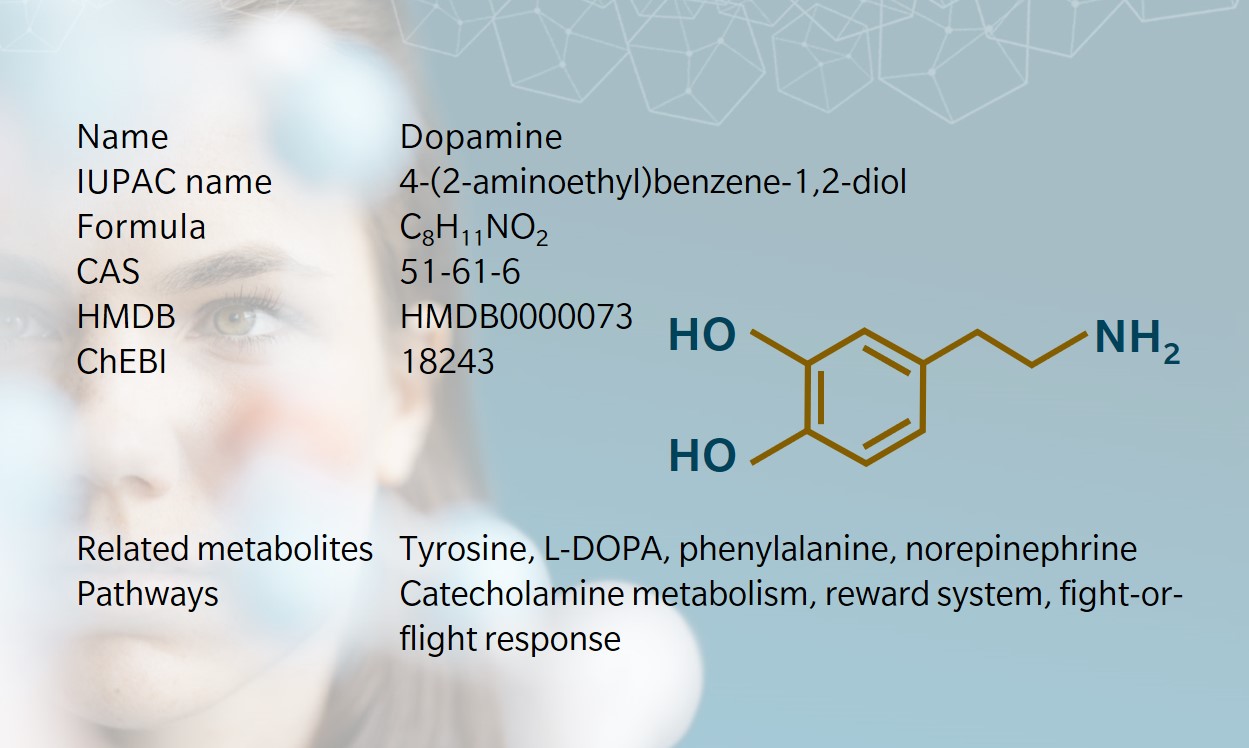History & Evolution
1910: first synthesis of dopamine by George Barger and James Ewens (London, UK) (Fahn 2008)
1957: discovery of dopamine’s presence in the brain by Katharine Montagu (London, UK)
Dopamine is a biogenic amine with several functions in the brain and body. First thought to be an insignificant intermediary in the metabolism of norepinephrine, dopamine was shown to lower blood pressure in 1957, and later identified as a major neurotransmitter in the brain (Marsden 2006; Hornykiewicz 2002). Since then, dopamine has been at the center of research in neurological and psychological conditions, and the metabolism of dopamine and dopamine pathways in the brain are now better understood. Dopamine also plays an important role outside the brain, notably via action on the kidneys and cardiovascular system (Marsden 2006).
Biosynthesis vs. dietary uptake
Dopamine is synthesized by both animals and plants. Dietary dopamine can be absorbed during digestion but has poor blood-brain barrier penetration (Haddad et al. 2017). In humans, dopamine can be synthesized in several organs including the brain, where L-dihydroxyphenylalanine (L-DOPA) is the main precursor of dopamine (Qi et al. 2008). L-DOPA, the origin for dopamine’s name, is formed from the amino acid tyrosine, which is found in our diet or synthesized internally from phenylalanine (Fahn 2008). Dopamine is also synthesized from L-DOPA in the kidneys, where it helps regulate sodium homeostasis and blood pressure (Carey 2001). In the adrenal glands, dopamine is involved in the production of norepinephrine (or noradrenaline), an important mediator of the fight-or-flight response (Mannelli et al. 1995; Pivonello et al. 2004).
Dopamine, addiction and memory
Dopamine is often associated with feelings of pleasure. It has been at the center of research on reward-motivated behavior and addictions since the discovery of its involvement in positive reinforcement in rats in the 1970s. In the following decades, researchers investigated the effects of various drugs on dopamine release and dopamine receptor expression, showing different patterns for different addictions (Nutt et al. 2015). Some speculate that these differences are due to an imbalance between the dopaminergic circuits that underlie the reward system and those involved in executive functions (Volkow et al. 2011).
Dopamine also helps to consolidate memories by sending signals via specific receptor combinations in the hippocampus and thus plays a key role in the retention of everyday memory (Yamasaki and Takeuchi 2017; Takeuchi et al. 2016).
Dopamine, neurology and psychological disorders
Perhaps the best-known application of dopamine research in neurology is the use of L-DOPA in the treatment of Parkinson’s disease (PD). Patients with PD were found to be deficient in dopamine, which prompted the use of dopamine-related molecules such as L-DOPA as potential treatments (Fahn 2008). In PD, neurodegeneration primarily affects the substantia nigra area of the brain, which is also where dopamine is produced. Interestingly, this area gets its name from its dark color, caused by high levels of neuromelanin, which is also a downstream metabolite of L-DOPA (Carballo-Carbajal et al. 2019).
Dopamine is also important to our understanding of schizophrenia. Early research linked the effectiveness of psychoactive drugs to their affinity for dopamine receptors (Howes et al. 2015). Later research revealed a complex picture at the molecular level. For example, post-mortem analysis of the brains of patients with schizophrenia revealed higher levels of tyrosine hydroxylase than in patients with depression and healthy controls. This enzyme is the rate-limiting step in the production of dopamine from tyrosine., which encourages dopamine production (Howes et al. 2013; Howes et al. 2015).
Dopamine and the kidneys
The kidneys have their own dopaminergic system, including dopamine synthesis from circulating L-DOPA, dopamine receptors, and dopamine signaling that contributes to core kidney functions (Qaddumi and Jose 2021; Martinez et al. 2020). In the proximal tubule, dopamine acts as an autocrine/paracrine mediator on renal receptors with both activating and inhibiting signals depending on the dopamine receptors expressed and activated. The combined effect of these signals is the fine regulation of sodium excretion in the urine, which in turn affects renal control of blood pressure (Carey 2001). Dopamine receptors in kidney cells also help to regulate oxidative stress, which is a primary mechanism of renal damage (Qaddumi and Jose 2021).
Dopamine and cardiometabolic diseases
In mammals, dopamine receptors are also found in significant amounts in the cardiovascular system (Ozono et al. 1997; Amenta et al. 1990). In cardiomyocytes, dopamine binds to dopamine receptors and adrenoreceptors, leading to the production of cyclic AMP, calcium-induced calcium release and eventually contraction (Bucolo et al. 2019; Lang et al. 1988). These processes contribute to metabolic function and help the heart pump blood efficiently. In endothelial cells, dopamine activates nitric oxide (NO) production. Here again, signaling mediated by cyclic AMP is involved, this time to activate the enzyme eNOS (endothelial nitric oxide synthase) responsible for NO production. NO then acts on nearby vascular smooth muscle cells to induce muscle relaxation and vasodilation. Dopamine also binds dopamine receptors in these smooth muscle cells to directly control vasoconstriction and vasodilation via competing activating/inhibiting signaling by cyclic AMP (Bucolo et al. 2019).
Dopamine and music
Neurobiologists have long been curious about what happens in the brain when humans enjoy music. The role of the reward system, and thereby of dopamine, is now fairly established in our positive response to music (Ferreri et al. 2019). Both anticipating and listening to music elicit an increase in dopamine levels, but in different pathways (Valorie N Salimpoor et al. 2011). Music has even been suggested to assist memory function in Alzheimer’s disease, in part through the dopaminergic pathway (Peck et al. 2016).

